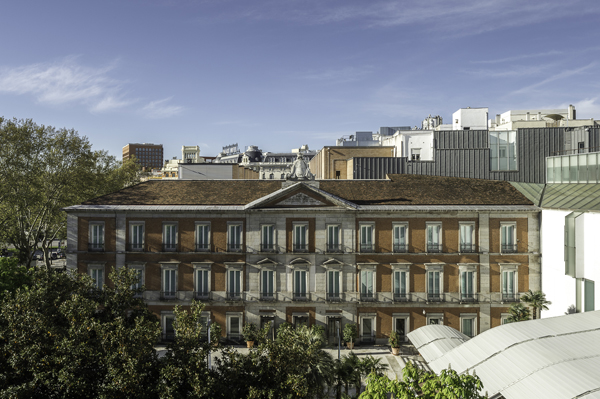From financial headquarters to museum: the building since the 1950s
From branch of the Banco Comercial Transatlántico to headquarters of the Banca López Quesada
After the Civil War, the palace still belonged to the Duke and Duchess of Villahermosa, although for a time it housed the National Fuel Union. In 1956, when Spain’s economy was beginning to take off, the first two ground-floor bays facing the Paseo del Prado were rented to the Banco Comercial Transatlántico and converted into a branch office. One of the old balconies on the Paseo del Prado was torn down to create an entrance to the bank, and access to the rest of the building was blocked off. However, the building still retained the complex layout of the original construction, as can be seen in the photographic report published in the magazine Blanco y Negro ten years later (08-01-1966).
In 1971, the whole building was sold to Banca López Quesada. Intending to convert it into a headquarters, the bank commissioned Fernando Moreno Barberá (1913−1998) to completely renovate it. Work began two years later and continued until 1976. Although the three façades were preserved, the interior was stripped out, three underground floors were excavated and a central trading floor was built, surrounded by a double bay. The public entrance was on the Carrera de San Jerónimo, and the private entrance − reserved for senior management and board members – was via the garden.
In 1983, however, the Banca López Quesada went bankrupt and was taken over by the Deposit Guarantee Fund, which in turn was responsible to the Bank of Spain. There were plans to incorporate the Villahermosa palace into the long-awaited extension of the neighbouring Museo del Prado. Indeed, it was even used as an exhibition hall for the Madrid art museum and as the offices of the Friends of the Prado Foundation. However, it was finally offered to Baron Hans Heinrich Thyssen-Bornemisza to house his collection in the future.
The Villahermosa palace houses the Museo Thyssen-Bornemisza
At this point Rafael Moneo (1937-) was entrusted with converting the Banca López Quesada into the Museo Thyssen-Bornemisza between 1989 and 1992. Respecting Antonio López Aguado’s initial design, Moneo decided to preserve the building’s original palatial character, but changed the layout of the bays, making them perpendicular to the Paseo del Prado. Although Moneo kept Moreno Barberá’s central courtyard, he narrowed it and connected it with the garden façade, which, unlike in Moreno Barberá’s design, became the backbone of the whole building and the sole entrance.
In 2004, in order to accommodate the loan of the Carmen Thyssen-Bornemisza collection, the museum was extended into the adjacent Goyeneche and Guaqui palaces. The adaptation of these historic buildings – preserving their façade − to the museum’s need for additional office and exhibition space was carried out by BOPBAA architects. A neutral façade of whitewashed concrete and glass was built overlooking the garden. Inside, however, the rooms of the original museum, with their bays perpendicular to the Paseo del Prado, were replicated with some variations. This latest refurbishment – as a result of which the former stables of the Villahermosa palace have been recovered – has brought to a close a fruitful period of two hundred years of history, with a museum open to the future.
Since 2021 the Museum, located within the Paseo del Prado and Parque del Retiro surrounding area, is included in Landscape of Light , one of the inscribed properties of the UNESCO World Heritage List.

Bibliography
If you want to know more about the history of the Museo Nacional Thyssen-Bornemisza's building, you can consult the following bibliography.
View bibliography


